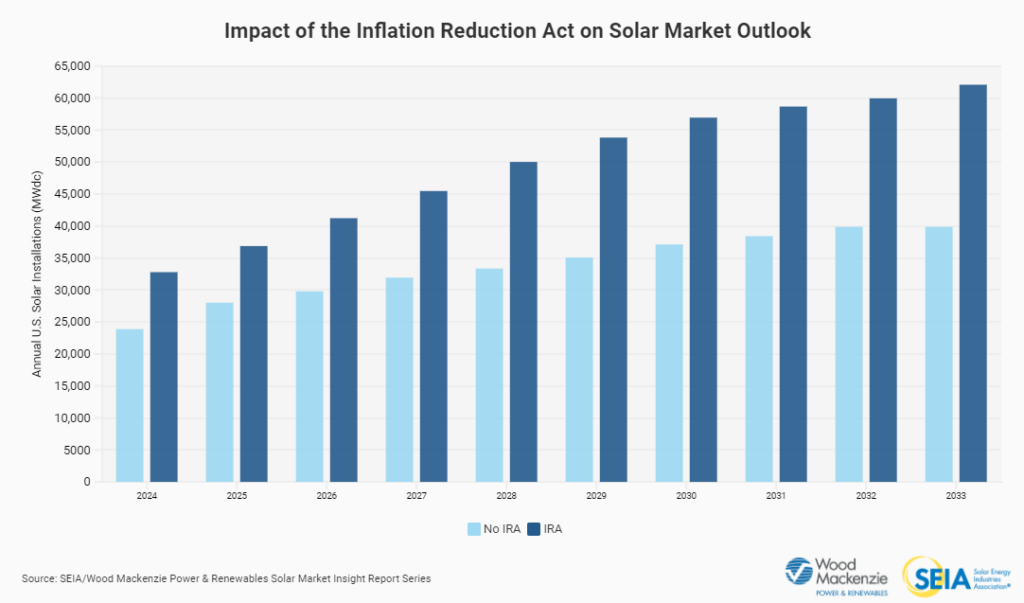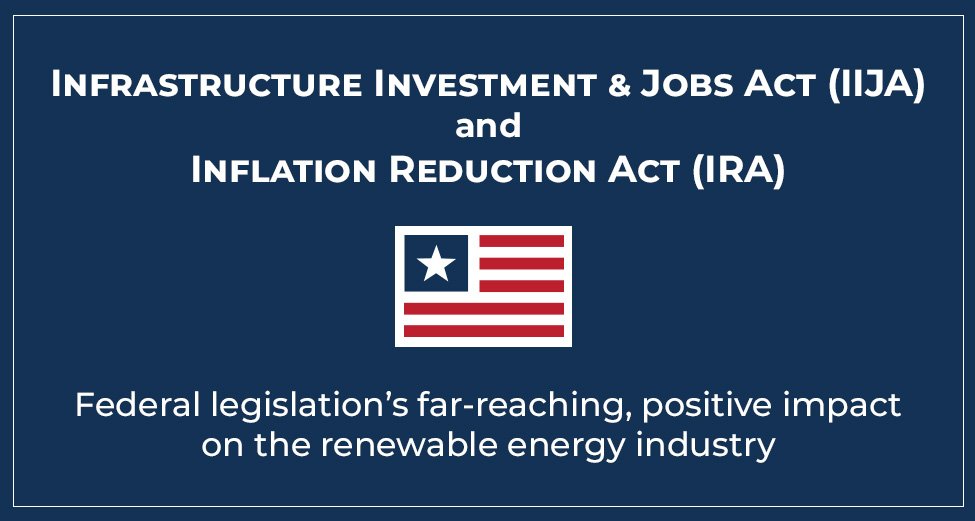The Infrastructure Investment and Jobs Act (IIJA), signed into law in November 2021, and the Inflation Reduction Act (IRA), enacted in August 2022, are having a far-reaching impact on the renewable energy industry. This federal legislation mandates historic investments in new or expanded programs, grants and tax credits, and to date more than $100 billion of these investments have materialized. The lion’s share of these investments is earmarked for the states with the most ambitious decarbonization targets and mandates, most notably California, as well as those states with greater renewable resources and lower permitting and siting costs, including Florida and Texas.
As a result of these investments, the Energy Information Administration expects renewable deployment to increase 17% to 42 GW in 2024 and account for almost a quarter of electricity generation.
The groundbreaking legislation spearheaded some specific outcomes:
A soar in solar and storage
The solar and storage industries appear to have benefited most from the IIJA and IRA:
- In 2023, U.S. solar and storage companies announced over $100 billion in new private-sector investments and the creation or expansion of 51 solar manufacturing facilities.
- Since the IRA passed, 155 gigawatts (GW) of new production capacity has been announced across the solar supply chain, including:
- 85 GW of solar modular capacity
- 43 GW of solar cells
- 20 GW of silicon ingots and wafers
- 7 GW of inverter capacity
- 165 GWh of energy storage manufacturing capacity has been announced across 14 new or expanded facilities
- By 2033, the U.S. will have installed 669 GW of total solar capacity, more than 4 times the amount installed today.
- By 2031, solar energy will produce more electricity yearly than all U.S. coal-fired power plants in 2022.
- The solar industry’s annual CO2 emissions offsets will increase from 169 million metric tons (MMT) today to more than 459 MMT by 2033.
Scaling up the clean hydrogen economy
Experts see hydrogen as an important tool to help reduce greenhouse gas emissions and allow the U.S. to reach net zero by 2050. It can serve as a low- or zero-carbon fuel for a variety of uses (transportation, industrial production, power generation, and energy storage) without producing any emissions. To reap these decarbonizing benefits, however, current hydrogen production has to shift to a cleaner and more affordable approach.
IIJA has stipulated an $8 billion investment to kickstart large-scale deployment of clean hydrogen production. The legislation calls for the first-ever incentive for clean hydrogen production: up to $3 of credit for every kilogram produced that meets a carbon intensity threshold. Subsequent legislation (the bipartisan 2023 Omnibus Appropriations Bill) has provided for federal funds to create regional clean hydrogen hubs and offer clean hydrogen production incentives and support for new research.
New investment in energy storage
The IIJA has called for significant investment in energy storage. These funds encompass a range of initiatives aimed at advancing energy efficiency and renewable energy. Among them are $6 billion in grants from DOE’s Office of Energy Efficiency and Renewable Energy, dedicated to processing, manufacturing, and recycling battery materials. Also, DOE’s Office of Clean Energy Demonstration allocated $505 million in grants or cooperative agreements for conducting energy storage demonstration projects.
Thanks to the legislation, the storage industry now has access to a federal investment tax credit (ITC) for the first time ever. Furthermore, projections indicate that battery storage installations will exceed 10 gigawatts (GW) per year for the foreseeable future. To ensure the full benefits of the IIJA, future grants for battery manufacturing will need to include a diversity of technologies appropriate for grid energy storage, encompassing both lithium- and non-lithium-based batteries and their components.
The implications for BEI
The IIJA and IRA stand as the most significant environmental legislation in history, driving growth in the entire renewable energy industry. As a result, BEI experiences increasing demand for our design and construction services across all sectors, including solar, wind, EV charging, BESS, and substations. We’re excited by the progress towards a more sustainable energy future and remain committed to making a difference. “It is a great time to be in the industry,” says Jerry Zampino, BEI General Manager of Energy Storage.

